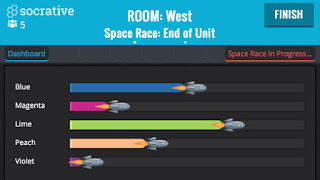 The fact that there are two different editions for this app makes it a little bit confusing. One could also complain that creating short quizzes like this constantly is too time-consuming. However, I believe that the immediate feedback is important and worth the time. Socrative allows for formative assessment whether it be in the form of a multiple choice quiz, ticket out the door, a quick question, or even space race.
The fact that there are two different editions for this app makes it a little bit confusing. One could also complain that creating short quizzes like this constantly is too time-consuming. However, I believe that the immediate feedback is important and worth the time. Socrative allows for formative assessment whether it be in the form of a multiple choice quiz, ticket out the door, a quick question, or even space race.Assessing student's learning is a crucial part of being a teacher. Simply teaching students a concept does not mean that they understand it. Assessment allows the teacher to either move to a new concept, or approach the concept that had just been covered in a different manner. Essentially, assessment should drive instruction.

Socrative allows this to occur in a manner in which students enjoy. Assessment does not need to be something that is stressful. Socrative allows the assessment to be laid-back yet at the same time, provide useful feedback from students to the teacher.
A teacher could use Socrative in their classroom a number of different ways.
The multiple choice quiz that Socrative provides could simply be used at the end of a class to see if the students understood the lesson that they had just received. However, a multiple choice quiz could also be used at the start of a class to see if students had done their homework, or even to assess if students remembered what they had learned last class.
Socrative's ticket out the door is not simply one question. Rather it allows the teacher to ask students three questions:
- How said student felt about the lesson.
- What they actually learned from the lesson.
- A response to a specific question that the teacher asks the class as a whole.
This variety allows students to display their knowledge from the class. It also encourages students to pay attention in class in order to be able to answer these questions when class is over. A teacher could use Socrative's ticket out the door as a method to encourage students to remain engaged and assess whether or not they understood important concepts.
Socratives' quick question is just that: a quick question. Creating a quick question allows teacher flexibility in how they can use it. Whether it be for extra credit, or simply to confirm students are paying attention, there are many ways in which one could use this tool from Socrative in the classroom.
Finally, the space race function of Socrative is most likely the most popular tool with students. Space Race divides students into teams and as they answer questions, their rocket moves across the board. The first team to answer all questions correctly then reaches the finish line first. Nicole Chubb describes here how popular the space race is amongst her students. She goes into more detail about how the game works and how to set it up.
Overall, Socrative is extremely user-friendly. However, a user's guide can be found here. I personally found the most difficult part of using Socrative was figuring out how to end a quiz. However, after a quick Google search I found this helpful page.
I would definitely use Socrative in my future classroom. Bradley Lands is another teacher that uses Socrative in his own classroom and only has positive statements about the app.
References
Socrative banner. (n.d.). Retrieved February 1, 2016, from https://blogs.shu.ac.uk/sbstel/files/2014/12/Soc2-Banner.png
Socrative space race. (n.d.). Retrieved February 1, 2016, from http://blogs.nvcc.edu/fsrc/files/2015/07/socrativespace-race.jpeg
Student reading. (n.d.). Retrieved February 1, 2016, from http://educationsc.com/wpcontent/uploads/2013/10/Student-Reading-Assess.jpg
I would definitely use Socrative in my future classroom. Bradley Lands is another teacher that uses Socrative in his own classroom and only has positive statements about the app.
References
Socrative banner. (n.d.). Retrieved February 1, 2016, from https://blogs.shu.ac.uk/sbstel/files/2014/12/Soc2-Banner.png
Socrative space race. (n.d.). Retrieved February 1, 2016, from http://blogs.nvcc.edu/fsrc/files/2015/07/socrativespace-race.jpeg
Student reading. (n.d.). Retrieved February 1, 2016, from http://educationsc.com/wpcontent/uploads/2013/10/Student-Reading-Assess.jpg

No comments:
Post a Comment